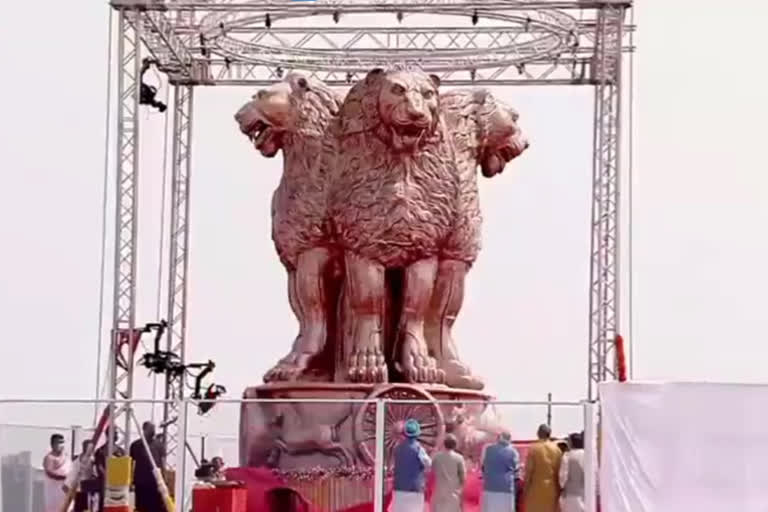Indore: Ever since Prime Minister Narendra Modi unveiled the National Emblem Ashoka Pillar on the roof of the new Parliament House, the opposition began accusing the central government of tampering with the original design of the Emblem.
The family of Dinanath Bhargava, a co-artist in the team that had designed the original national emblem of India, termed the lions made in the original Ashoka Pillar as peace-loving. Prabha Bhargava, 85, the late painter's wife claims the lions in the new pillar have been depicted in a fierce form, as the mouths of the lions are open in an aggressive manner.
"That was a peaceful time. It was not like today when everyone is busy pulling others down. Whoever has made it, has made it. At that time, Bhargava sahabhad kept in mind that since the picture was to be used on the front page of the Constitution, the lions should be painted in such a way that they reflect peace. I have heard that in the latest emblem that has been sculpted, the lions have been shown to be ferocious. That is why there is this controversy. Though I have not seen it, I think they could have made it better," Prabha told ETV Bharat.
National Emblem Row: Original painting revealed by family In order to accomplish the task, Dinanath Bhargava visited a zoo in Kolkata for three months to closely observe lions. The family members recalled this amid the row over the national emblem installed atop the new Parliament building, to which the opposition parties have taken objections, accusing the Centre of replacing the "graceful and regally confident" Ashokan lions with those having menacing and aggressive posture.
Also read:PM Modi unveils national emblem on new Parliament building
The opposition parties claimed the government has made changes to the Ashoka Pillar's original form. The new one was prepared under the supervision of PM Modi. The architect of the new pillar, Sunil Deore claims he made very few changes, and it is 99 percent similar to the original work. Late Dinanath Bhargava was part of a group, which designed the national emblem that decorated the Indian Constitution's manuscript. The group had drawn inspiration from the ancient sculpture 'Lion Capital of Ashoka' which dates back to 250 BC at Sarnath in Uttar Pradesh.
"India's first Prime Minister Jawaharlal Nehru had given the task of designing the Constitution's original manuscript to Ravindranath Tagore's Shantiniketan's Kala Bhavan principal and noted painter Nandalal Bose," Prabha said on Wednesday. Late Bose had handed over the task of creating the Ashok Stambh's picture to her husband, who was young at that time and studying Arts in the Shantiniketan, she said.
"After the directives of his guru, my husband continuously visited Kolkata's zoo for three months to closely observe lions for their expressions and to see how they sit and stand," she said. The original picture is still in the family's possession. Amid the controversy, Bhargava's family shared the original picture painted by him.
His wife revealed that in the picture painted by her husband, "The lion appears to be sitting calmly with his female and child, as this picture was to be used in the symbol of the constitution. For this reason, he at that time incorporated the calm instincts of lions in this rare picture of him." The artwork, according to Prabha was painted with gold leaf, and the mouths of the lions are slightly open, and their teeth are also visible. The bottom part of the painting reads 'Satyamev Jayate' also written in gold.
Dinanath's daughter-in-law made no comments on the controversy and demanded that any art gallery, place, or museum in Madhya Pradesh be named after Dinanath Bhargava to preserve the memory of the artwork that he had designed for the Constitution. "Despite several leaders' assurances to the family on the issue, this demand has remained unfulfilled till date," she said.
Dinanath Bhargava hailed from Betul town in Madhya Pradesh. He died on December 24, 2016, at the age of 89 years in Indore, the family members added. The Ashoka Pillar is the national emblem of India, it was originally used by Emperor Ashoka to spread Lord Budhha's message of peace. The four lions seen on the upper part of the Ashoka pillars represent courage, strength, confidence, and pride. A circular abacus on which the lions stand is adorned with the engravings of a bull, a horse, and an elephant.
The Ashoka Pillar is present on every official document in India, from passports to currency. Even the Indian flag pays homage to Ashoka, as the Ashoka Chakra was installed in the middle part of the flag. This insignia represents the war skills and the policy of peace adopted by Emperor Ashoka, whose kingdom extended from Taxila in the north to the Godavari river, Swarnagiri hills, and Mysuru in the south.
